Great by Choice: Uncertainty, Chaos and Luck - Why Some Thrive Despite Them All
4.6 out of 5
1,765 global ratings
The New Question
Ten years after the worldwide bestseller Good to Great, Jim Collins returns with another groundbreaking work, this time to ask: Why do some companies thrive in uncertainty, even chaos, and others do not? Based on nine years of research, buttressed by rigorous analysis and infused with engaging stories, Collins and his colleague, Morten Hansen, enumerate the principles for building a truly great enterprise in unpredictable, tumultuous, and fast-moving times.
The New Study
Great by Choice distinguishes itself from Collins's prior work by its focus not just on performance, but also on the type of unstable environments faced by leaders today. With a team of more than twenty researchers, Collins and Hansen studied companies that rose to greatness--beating their industry indexes by a minimum of ten times over fifteen years--in environments characterized by big forces and rapid shifts that leaders could not predict or control. The research team then contrasted these "10X companies" to a carefully selected set of comparison companies that failed to achieve greatness in similarly extreme environments.
The New Findings
The study results were full of provocative surprises. Such as:
- The best leaders were not more risk taking, more visionary, and more creative than the comparisons; they were more disciplined, more empirical, and more paranoid.
- Innovation by itself turns out not to be the trump card in a chaotic and uncertain world; more important is the ability to scale innovation, to blend creativity with discipline.
- Following the belief that leading in a "fast world" always requires "fast decisions" and "fast action" is a good way to get killed.
- The great companies changed less in reaction to a radically changing world than the comparison companies.
The authors challenge conventional wisdom with thought-provoking, sticky, and supremely practical concepts. They include 10Xers; the 20 Mile March; Fire Bullets then Cannonballs; Leading above the Death Line; Zoom Out, Then Zoom In; and the SMaC Recipe. Finally, in the last chapter, Collins and Hansen present their most provocative and original analysis: defining, quantifying, and studying the role of luck. The great companies and the leaders who built them were not luckier than the comparisons, but they did get a higher Return on Luck. This book is classic Collins: contrarian, data-driven, and uplifting. He and Hansen show convincingly that, even in a chaotic and uncertain world, greatness happens by choice, not by chance.
320 pages,
Kindle
Audiobook
Hardcover
Audio CD
First published October 12, 2011
ISBN 9781847940889
About the authors
Jim Collins
Jim Collins is a student and teacher of what makes great companies tick, and a Socratic advisor to leaders in the business and social sectors. Having invested more than a quarter century in rigorous research, he has authored or coauthored a series of books that have sold in total more than 10 million copies worldwide. They include Good to Great, the #1 bestseller, which examines why some companies make the leap and others don’t; the enduring classic Built to Last, which discovers why some companies remain visionary for generations; How the Mighty Fall, which delves into how once-great companies can self-destruct; and Great by Choice, which uncovers the leadership behaviors for thriving in chaos and uncertainty. Jim has also published two monographs that extend the ideas in his primary books: Good to Great and the Social Sectors and Turning the Flywheel.
His most recent publication is BE 2.0 (Beyond Entrepreneurship 2.0), an ambitious upgrade of his very first book; it returns Jim to his original focus on small, entrepreneurial companies and honors his coauthor and mentor Bill Lazier.
Driven by a relentless curiosity, Jim began his research and teaching career on the faculty at the Stanford Graduate School of Business, where he received the Distinguished Teaching Award in 1992. In 1995, he founded a management laboratory in Boulder, Colorado, where he conducts research and engages with CEOs and senior-leadership teams.
In addition to his work in the business sector, Jim has a passion for learning and teaching in the social sectors, including education, healthcare, government, faith-based organizations, social ventures, and cause-driven nonprofits. In 2012 and 2013, he had the honor to serve a two-year appointment as the Class of 1951 Chair for the Study of Leadership at the United States Military Academy at West Point.
Jim holds a bachelor's degree in mathematical sciences and an MBA from Stanford University, and honorary doctoral degrees from the University of Colorado and the Peter F. Drucker Graduate School of Management at Claremont Graduate University. In 2017, Forbes selected Jim as one of the 100 Greatest Living Business Minds.
Read more
Reviews
John W. Pearson
5
Jim Collins Lexicon 2.0
Reviewed in the United States on November 8, 2011
Verified Purchase
True or false? An author's first book is his or her best. The second, third or (horrors) fourth book will aptly document the slippery slope into mediocrity.
Usually true. But if the book is by Jim Collins, the myth is false. And all of us are grateful.
His latest, "Great by Choice," keeps his reputation intact for high quality, fascinating, page-turning story/research/label/principle serious management thinking. If you learned from "Built to Last," "Good to Great,"
Read more
2 people found this helpful
Wally Bock
5
I learn something new every time I return to this book
Reviewed in the United States on February 6, 2017
Verified Purchase
A couple of years ago, I picked up Jim Collins and Morten Hansen’s book Great by Choice: Uncertainty, Chaos, And Luck – Why Some Thrive Despite Them All to check a few facts. Two hours later, I was still reading. Recently, that happened again.
I realized that I never reviewed Great by Choice for my website, so I picked it up and, just like the last time, found myself still reading a couple of hours later. I think Great by Choice is, Jim Collins’ best book. The partnership with Morten Hansen makes the reasoning tighter and the research a bit broader than in Collins’ other books. Here’s the authors’ statement of what they want the book to achieve.
“First, we believe the future will remain unpredictable and the world unstable for the rest of our lives, and we wanted to understand the factors that distinguish great organizations, those that prevail against extreme odds, in such environments. Second, by looking at the best companies and their leaders in extreme environments, we gain insights that might otherwise remain hidden when studying leaders in more tranquil settings.”
The opening chapter, Thriving in Uncertainty, is an introduction to the book. The research is typical Jim Collins. He went looking for enterprises that had great performance over many years in a particularly turbulent environment and that started from a position of vulnerability.
In this chapter, the authors share their findings about five what they call “entrenched myths” that were disproved by their research. Here are the myths.
- Successful leaders in a turbulent world are bold, risk-seeking visionaries.
- Innovation distinguishes those companies that succeed in a fast-moving, uncertain and chaotic world.
- A threat-filled world favors the speedy.
- Radical change on the outside requires radical change on the inside.
- Great enterprises have a lot better luck than other enterprises.
All of those, are false. So, what is this book about? It’s simple, Great by Choice will prepare you to succeed in a world that you cannot predict.
Chapter two is “10Xers.” That’s what the authors call the super successful and adaptable companies that they studied. The core of the chapter is the story of Roald Amundsen and his race to the South Pole. Next, they define 10X leadership as three important things: fanatic discipline; productive paranoia; empirical creativity.
Every chapter ends the same way. There’s a summary of key findings, of course, but also unexpected findings and another part called “One Key Question,” which they suggest you answer.
The authors call chapter three “The 20-Mile March” and it’s about having concrete, clear, and rigorous performance mechanisms that keep you on track. They phrase this philosophy as a commitment to high performance in difficult conditions and (this is important) “the discomfort of holding back in good conditions.”
This all made sense to me. I’m a proponent of getting a little better, pushing forward, and making a little progress every day. The finding that I found surprising and helpful was that the idea of the 20-mile march also includes not pressing too hard ahead when conditions are good. It’s a continued steadiness. When times are good, stick to your discipline. Don’t try to go explosive.
Chapter four is titled “Fire Bullets, Then Cannonballs.” For the authors, a bullet is a test that you make to determine what works. A bullet is a low-cost, low-risk, low-distraction trial. It’s what puts the “empirical” in “empirical creativity.”
This is what I learned in my early direct-response career. You test things. When those things work, you expand a little bit, but you also understand that many of the things you test won’t work.
Chapter five is “Leading above the Death Line.” The chapter is about risk in two areas. First, it is about the things you can do to minimize the risk of unforeseen and uncontrollable events. Then, the authors talk about three kinds of risk. Death line risk is where there’s a risk of destroying or severely damaging the enterprise. Asymmetric risk is where the downside is much larger than the upside. Uncontrollable risk is what it sounds like, something that can’t be either controlled or managed. The big takeaway for me is in the “One Key Question” that the authors suggested you ask about yourself and your enterprise: “How much time before the risk profile changes?”
Chapter six is about “SMaC.” SMaC stands for Specific, Methodical, and Consistent. The lessons in this chapter were a lot like the ones in “20-Mile March” chapter. The key point is that in an uncertain, fast-changing environment, you need to be specific, methodical, and consistent.
The final chapter is about “Return on Luck.” As you might expect, the basic thing to learn is you’re going to have good luck and you’re going to have bad luck, and what’s going to matter is what you do with it. That’s a lot like the message of a bevy of motivational speakers, but it’s still important. My mother had a question she asked in all kinds of situations: “What good can we make of this?” You improve your return on luck by asking questions like that
Bottom Line
As with every book with Jim Collins’ name on the cover, this one is superbly written with dozens of well-told stories, liberally seasoned with facts. What makes this book special is the tightness of the reasoning and the phrasing of the research. The big plus of this book, for me, was that this is not only about organizations. You can apply the things you find here to a career or a project or just about any part of life. You’re going to have luck. It’s what you do with it that matters. To find out how to do the best possible job dealing with the luck you get, read Great by Choice.
Read more
31 people found this helpful

Chris Grams
5
Another great book in the same vein
Reviewed in the United States on October 26, 2011
Verified Purchase
I admit it. I'm a total Jim Collins fanboy.
Ever since I first read the book Built to Last in 2002, I've been a willing member of the cult of Jim Collins. At my previous company, we took some of the ideas from Built to Last as inspiration for the process we used to uncover our organizational values. Then we later employed many of the principles from Collins' next book Good to Great as we further developed the positioning, brand, and culture.
While many of the Big Concepts (TM) expressed in these books may initially seem a bit cheesy and Overly Branded (TM), I've come to love and occasionally use some of the terms like BHAGs (Big Hairy Audacious Goals), the Tyranny of the OR, Level 5 Leadership, and my longtime favorite The Hedgehog Concept. Why?
Because they are just so damn useful. They make the incredibly complex mechanics behind successful and not-so-successful organizations and leaders simple and easy for anyone to understand. They are accessible ideas and you don't have to be a former management consultant with an MBA from Harvard in order to understand how to apply these principles to your own organization.
I'd go so far as to say that over the past fifteen years, no one has done more than Jim Collins to democratize the process of creating a great organization.
So when I found out that Jim Collins had a new book coming out, his first since the rather dark and depressing (but no less useful) How the Mighty Fall in 2009, and that he'd been working on this new book with his co-author Morten Hansen for the last nine years, I was ready for my next fix.
I finished the new book, entitled Great by Choice: Uncertainty, Chaos, and Luck--Why Some Thrive Despite Them All a few nights ago, and here are my thoughts.
This book comes from the same general neighborhood Collins explores in his previous books (I'd describe this neighborhood as "what makes some companies awesome and others... not so much"), but instead of simply rehashing the same principles, this book explores a particularly timely subject. From Chapter 1, here's how Collins and Hansen set up the premise:
"Why do some companies thrive in uncertainty, even chaos, and others do not? When buffeted by tumultuous events, when hit by big, fast-moving forces that we can neither predict nor control, what distinguishes those who perform exceptionally well from those who underperform or worse?"
In other words, what common characteristics are found in companies that thrive when the going gets wacky? (Times like, for instance... right now.)
In this book Collins and Hansen clearly did an immense amount of research to answer this question. In fact, as with Built to Last and Good to Great, the appendixes at the end "showing the math" for how they reached their conclusions take a third or more of the book.
Their research led to a set of companies that they refer to as the "10x" cases because, during the study period, these companies outperformed the rest of their industry by 10 times or more. After looking at over 20,000 companies, the final organizations that made the cut were Amgen, Biomet, Intel, Microsoft, Progressive Insurance, Southwest Airlines, and Stryker.
Now you may look at this list, as I did, and say to yourself, "Okay, I get Southwest Airlines and Progressive Insurance... but Microsoft????"
Well, as it turns out, the period they were studying wasn't up until the present day. Because this research began nine years ago, they were studying the companies from 1965 (or their founding date if it was later) until 2002. So in that context, the choice of Microsoft makes a lot more sense. In 2002, Microsoft was still firing on all cylinders.
I won't spoil the whole book for you, but Great by Choice has an entirely new set of Big Concepts (TM) that will help you understand the characteristics that set these companies apart from their peers. This time around, we are introduced to:
- The 20 Mile March: Consistent execution without overreaching in good times or underachieving in bad times.
- Firing Bullets, Then Cannonballs: Testing concepts in small ways and then making adjustments rather than placing big, unproven bets. But then placing big bets when you have figured out exactly where to aim.
- Leading above the Death Line: Learning how to effectively manage risk so that the risks your organization take never put it in mortal danger.
- Return on Luck: My favorite quote from the book perfectly articulates the concept: "The critical question is not whether you'll have luck, but what you do with the luck that you get."
Many of these concepts come with an awesome allegorical story to illustrate them. That's the great thing about a Jim Collins book: you can't always tell whether you are reading a business book or an adventure book. In this case Collins (who is also an avid rock climber himself) shares tales from an ill-fated Everest expedition, the race for the South Pole, and a near death climbing experience in Alaska interspersed with specific stories from the businesses he is profiling.
Overall assessment: The book is a fitting companion to Built to Last, Good to Great, and How the Mighty Fall. Simple, accessible, easy to digest, and with some very actionable key concepts that you can immediately put to use. And, unless you read all of the research data at the end, you'll find it to be a quick read that you can likely finish on a plane trip or in an afternoon.
Read more
3 people found this helpful
Mark P. McDonald
5
Great by Choice is the second/better half of How the Mighty Fall
Reviewed in the United States on October 16, 2011
Verified Purchase
Jim Collins extends and deepens the body of knowledge around the fundamentals of success. Great by Choice represents the second half of Collin's earlier book on company failure - How the Mighty Fall. While that earlier book concentrated on factors that drive failure, this describes the characteristics of sustained success.
This book is classic Collins. Well researched, clearly describes and expertly packaged for executives to incorporate these concepts into their lexicon and thoughts. This book is recommended as the capstone of the study of the fundamentals of great companies.
Great by Choice is a lot like How the Mighty Fall as it's a short, concise and focused book. About half of it is content and half is appendices, FAQs and methodology - just like HtMF. Put the two together and you get a comprehensive look at modern corporate success.
This is a book for understanding and admiring the factors Collin's points out as driving superior performance.
The book describes these factors, but description is not prescription.
This book is not a 'how to' book, nor one that provides much action oriented help. It relies on the reader understanding Collins points and then tailoring them to their situation. That places the burden of value on the reader, which is where it should be as greatness is less a recipe than a recommitment to hard work.
Great by Choice contains a set of core concepts that define the major chapters in the book. Here is a short description of each to provide an idea of what is in Great by Choice and how Collins describes the characteristics of companies that have exceptional performance, what Collins calls 10x.
20 Mile March describes the fanatic discipline that leads you to manage for the long term rather than chasing short-term results or the fade. Essentially this is the business version of the classical Greek axiom of balance and discipline.
Fire Bullets, Then Cannonballs by being empirically creative by experimenting intelligently everywhere and exploit where you know you are having success. This is more than the idea of `failing fast'. It is a definition of innovation based on the combination of creativity, discipline and data.
Leading above the death line describes the productive paranoia that was captured by Andy Grove's management mantra. This is a business version of the Boy Scout's principle of `Be Prepared.' This chapter concentrates on the success and practices of preparation and having reserves that enable you to achieve more.
SMaC describes the company's principles that are Specific, Methodolical and Consistent. This chapter in essence describes the power of common vision, direction and culture. Collins points out that SMaC is one of the more powerful ways to exert control in a dynamic world.
Return on Luck discusses how leaders and laggards face unpredictable positive and negative events. This is perhaps one of the best chapters as it describes how Collins and his team investigated the phenomenon of luck. As expected the conclusion is that luck does not play a guiding factor, rather its how you take advantage of good luck and are prepared (death line) for bad luck.
These concepts are all interrelated and go beyond the book' s triangle graphic. You cannot do a 20 mile march well without SMAC and both are worth lest without the preparation associated with leading above the death line.
Overall, I recommend Great by Choice for both fan's of Collins' work and for people who are new to this discussion. Yes this book is a continuation the prior books, but it does a great job of providing new insight without overly repeating prior points.
Great By Choice to be a good place for people to start. You do not need to read Collin's other books, but logically this book is the second half of How the Mighty Fall. I would suggest that if you are going to read both that you read HtMF first as you need to fix that first before the ideas in this book will have an effect.
Strengths
The book contains strong ideas that are simple to communicate and easy to mentally think about how they fit with your organization. Its easy to see how they would may your company a 10X performer.
The case descriptions are informative, insightful and illustrative. The cases are well worn: Southwest Airlines, Microsoft, Apple, Progressive Insurance and Intel, but well applied.
The use of mountaineering and explorers as non-business based examples will give you the stories to tell around the water cooler.
Challenges
The book provides powerful description of concepts that we already know. Rewriting Collins' points boil down to the following: have along term vision (20 miles), experiment to innovate (bullets and canon), `Be Prepared' (death line), follow your core (SMaC) and take advantage when possible (Return on Luck)
The companies featured are studied from 1977 to 2002 which was a period of significant change: the internet, oil crisis, stagflation, etc. However, historically economists have dubbed this period part of what they call the great moderation. So while these principles are timeless, they do not account for what has happened and happening now.
There is no treatment of technology in the book. Given that much of the global, collaborative and social world is driven by technology, this is a big omission.
Read more
52 people found this helpful
Jim Clemmer
5
Aptly Titled with Practical Leadership Tips and Techniques
Reviewed in the United States on November 26, 2011
Verified Purchase
This is a very timely, inspiring, and practical book for leading in turbulent times. It's the culmination of a nine year research project that began in 2002 "in the aftermath of 9/11 and the bursting stock bubble, watching the exponential rise of global competition and the relentless onslaught of technological disruption, hearing the rising chant of '~change, change, change.'"
While a faculty member at Harvard Business School, Morten Hansen provided Jim Collins with input on his seminal book, "Good to Great." In the turbulent times after 9/11, they talked further about their strong sense that "uncertainty is permanent, chaotic times are normal, change is accelerating, and instability will likely characterize the rest of our lives." How true that's proved to be in the last 10 years!
The central question that began the nine year research quest and led to publishing "Great by Choice," was why do some thrive in the face of immense uncertainty, even chaos, and others do not? So they looked for companies that started in vulnerable positions and rose to spectacular performance in dangerously fast changing, unstable environments with major events and forces outside of their control. Sounding familiar?
As with Collins' first book, "Built to Last," and with "Good to Great" they compared the outstanding companies to a control group of comparison companies in the very same industries and extreme environments that failed to thrive. Many failed altogether and are no longer with us. They started with a list of 20,400 companies and went through 11 stages of cutting, screening, and shifting to identify the "10Xers." They called them "10 times companies" because they didn't merely get by or just become successful. They truly thrived. Every 10X case beat its industry index by at least 10 times." During the 30 year period of this research study, the 10Xers beat their industry stock performance indices by 32 times! Where's that time traveling machine to go back and make those investments?
The book is structured around the main finding of the research. This boils down to three core behaviors:
-
"Fanatic discipline: 10Xers display extreme consistency of action -- "consistency with values, goals, performance standards, and methods. They are utterly relentless, monomaniacal, unbending in their focus on their quests.
-
Empirical creativity: When faced with uncertainty, 10Xers do not look primarily to other people, conventional wisdom, authority figures, or peers for direction; they look primarily to empirical evidence. They rely upon direct observation, practical experimentation, and direct engagement with tangible evidence. They make their bold, creative moves from a sound empirical base.
-
Productive paranoia: 10Xers maintain hyper-vigilance, staying highly attuned to threats and changes in their environment, even when -- especially when -- all's going well. They assume conditions will turn against them, at perhaps the worst possible moment. They channel their fear and worry into action, preparing, developing contingency plans, building buffers, and maintaining large margins of safety."
The authors also found that "underlying the three core 10Xer behaviors is a motivating force: passion and ambition for a cause or company larger than themselves. They have egos, but their egos are channeled into their companies and their purposes, not personal aggrandizement."
An especially fascinating chapter reports their findings on what role luck played in the 10Xers success and the failure of their comparison companies. They concluded: "The best leaders we've studied maintain a paradoxical relationship to luck. On the one hand, they credit good luck in retrospect for having played a role in their achievements, despite the undeniable fact that others were just as lucky. On the other hand, they don't blame bad luck for failures, and they hold only themselves responsible if they fail to turn their luck into great results. 10Xers grasp that if they blame bad luck for failure, they capitulate to fate. Equally, they grasp that if they fail to perceive when good luck helped, they might overestimate their own skill and leave themselves exposed when good luck runs dry. There might be more good luck down the road, but 10Xers never count on it."
"Great by Choice" is very aptly titled. Collins and Hansen present incredibly strong evidence through their exhaustive research (which included reviewing 7,000 historical documents!) that it's not what happens to us but what we do about it; "...this study shows that whether we prevail or fail, endure or die, depends more upon what we do than on what the world does to us...every 10Xer made mistakes, even some very big mistakes, yet was able to self-correct, survive, and build greatness."
Read more
2 people found this helpful
John Rumley
5
Great By Choice: A very inspiring read
Reviewed in the United States on March 25, 2012
Verified Purchase
A company's greatness in our chaotic and uncertain world is not primarily a matter of circumstance. It is the product of its leaders and its people who make the company great by the conscious choices which they craft and through their strength in discipline. In the book, Great By Choice: Uncertainty, Chas, and Luck - Why Some Thrive Despite Them All, authors Jim Collins and Morten T. Hansen utilize case studies of successful companies and their CEO's while comparing operating strategies and results with those of the company's closest competition within their industry.
Collins and Morten develop the term 10Xer companies to demonstrate the advantageous components which are comparable in many successful companies. The authors have identified 10X companies, because these organizations in every case presented in the book, beat their industry index by at least 10 times. The 10Xer's share a set of behavioral traits that distinguished them from the leadership of the competitors to which they are being compared.
These traits or core behaviors are expanded upon through the company case comparisons and are: Fanatic discipline, empirical creativity, and productive paranoia. There is a central motivating force which is at the center of this triad of core behaviors that is termed: Level 5 Ambition; leaders who are incredibly ambitious, but their ambition is just and foremost for the cause, for the company, for the work, and not for themselves. These company leaders from the 10X case studies care as much about values as victory, as much about purpose as profit, and as much about being useful as being successful. The book also contains an interesting discussion on Luck and Return on Luck (ROL).
The 10Xer leaders who operate within the triad of core behaviors and hold Level 5 ambition never relax when they are blessed with good luck and they never wallow in despair when hit with bad luck. They keep pursuing their overall goal or cause. The authors describe the following concepts individually and then bring them together to show how to help increase your ROL: 20 Mile March; fire bullets - then cannonballs; leading above the Death Line; and SMaC: Specific, Methodical, and Consistent.
I recommend Great By Choice: Uncertainty,Chaos, and Luck - Why Some Thrive Despite Them All, to anyone who wants to be involved with their business in a manner that can help develop continued success of the company through its leadership. The factors that determine whether or not a company becomes truly great, even in a chaotic and uncertain world, lie largely within the hands of its people.
Read more
Owen Jackson
5
Will you choose greatness?
Reviewed in the United States on October 14, 2011
Verified Purchase
In Collins' new book he relies on the method you've seen in previous books like Built to Last and Good to Great. What's different in this one is he selected companies not just on their status or explosive growth, but because they succeeded in an extreme and uncertain environment. However, there's a caveat here: his research stopped in 2002, meaning there's no thorough analysis of how companies performed in the last 10 years (aka one of the most uncertain and chaotic business climates in decades). Collins and Hansen believe the future will be unstable and environments will be extreme for the rest of "our lives" (remember, these guys aren't Spring Chickens). So, they try to analyze company performance/greatness within the context of difficulty.
I always wish Amazon would show an easy-to-find Table of Contents for books, so I've created one for you here, complete with a summary of each chapter/section.
1 - THRIVING IN UNCERTAINTY Collins and Hansen explain what the method for their book (what I described above), including the definition of a 10Xer, which is a company that beat their industry by 10 fold. Just 7 companies were selected as a 10X case out of 20,400 companies. The seven are Amgen, Biomet, Intel, Microsoft, Progressive Insurance, Southwest Airlines, and Stryker. They don't include Apple because their research lens of Apple vs. Microsoft focused primarily on the 1980s and 1990s (remember they stopped collecting data in 2002), which makes no sense to me. The present environment (the one in which Apple has exploded) is a far more difficult climate than the 80s-90s.
2 - 10Xers Example of a 10xer is Southwest airlines, whose growth since 1972 is greater than that of Walmart, despite this period being a particularly harsh one for the airline industry. Anecdotes describe historic examples of 10xers and explains they aren't more creative, more visionary, more charismatic, or more ambitious, more blessed by luck, more risk seeking, more heroic, or more bold. The glaring fact that Apple is missing goes against this model, as Jobs and company were many of these things.
3 - 20 MILE MARCH Here they introduce discipline as the key that sets 10Xers apart (hence the 20 mile march). 10Xers are focused on data with GREAT discipline and stick to their plan, like a 20 Mile March.
4 - FIRE BULLETS, THEN CANNONBALLS 10Xers were not more innovative than the control companies; indeed, they were considered less innovative in some comparisons. 10Xers scale innovation (firing bullets) and then the fire cannonballs once they know what's on target.
5 - LEADING ABOVE THE DEATH LINE Explains "productive paranoia," the idea that you need to build cash reserves and buffers, bound your risk, and show flexibility in looking at macro and micro factors at play in your business and industry.
6 - SMaC SMaC stands for Specific, Methodological, and Consistent. The more uncertain your environment, the more SMaC you need to be. A SMaC recipe is a set of durable operating principles and practices that create a replicable and consistent success formula.
7 - ROL (RETURN ON LUCK) 10Xers weren't more lucky or unlucky than comparisons. They had better ROL because they took full advantage of good luck and minimized the effects of bad luck. If you think about it, that's the real key to luck. Knowing when you got lucky and how to take advantage of it, rather than blindly thinking you walk on water (like so many businesses do).
Like Jim's other books, the how to is what's missing. An outstanding book for that (increasing your leadership skill set) is
Read more
317 people found this helpful
AdamSmythe
5
Steady Marching Through Chaotic Times.
Reviewed in the United States on October 11, 2011
Verified Purchase
Jim Collins is at it again. Collins, along with co-author Morten Hansen and a team of over 20 researchers, spent roughly nine years trying to determine why some companies thrive during chaotic, uncertain and unstable times while other companies do not. If you have read some of Collins' earlier books, the theme in "Great by Choice" certainly won't surprise you. In "Built to Last," published in 1994, Collins, co-author Jerry Porras and their research team wrote about what makes for a "visionary" company, comparing a group of objectively and subjectively defined visionary companies with comparison companies that weren't so visionary. The authors would argue that their company selections were much more objectively chosen, and I wouldn't argue much with that claim. In "Good to Great," published in 2001, Collins and his research team analyzed a number of good companies that took the next step to achieve greatness, while a comparison group of similar companies did not.
In both of these two earlier books, as well in the current one (I'll get to "Great by Choice" presently), the authors conspicuously note how much better the subject companies performed, stock market wise, compared to the comparison companies. However, it is important to realize that Collins and his co-authors are not suggesting that you run out and invest in their subject companies. If you did that for the "Built to Last" companies, your investments would have included Citigroup, Ford, Sony and other companies that subsequently didn't set the world on fire. Similarly, from the "Good to Great" focus companies, Circuit City eventually filled for bankruptcy and Fannie Mae proved to be a major disappointment, in more ways than one. The point is that the reader can learn from what these companies did during their periods of success, regardless of whether some of the companies lost their way later on. Interestingly, one company, Wells Fargo, actually went from the comparison list in "Built to Last" to the focus list in "Good to Great." Okay, forewarned is forearmed regarding investing in the subject companies.
A couple of years ago Collins wrote another book, "How the Mighty Fall," which is a study of leadership failure, not success. This short book is a very enjoyable and informative read, but somewhat different from the books I mentioned above. All of Collins' books are interesting, hard to put down, and written with a passion for understanding the mechanisms of corporate success. When it comes to writing, I think of him as the Michael Lewis of management gurus. Collins is also an exceptional speaker, if you ever have the chance to hear him.
In "Great by Choice," Collins and Hansen select just seven companies (out of an initial list of over 20,000) as examples of those that have thrived during chaotic times. The companies are Amgen, Biomet, Intel, Microsoft, Progressive Insurance, Southwest Airlines and Stryker. These companies are called "10X" companies, given that their stock prices outdistanced the comparison companies by roughly an order of magnitude during the study period. Consider, for example, Southwest Airlines. During the study period (1970s through 2002), Southwest faced fuel price jumps, deregulation, labor problems in the airline industry, competitors moving through the revolving door of bankruptcy, and an absence of flyers in the aftermath of September 11, 2001. Still, the company consistently grew and prospered. During this time, comparison company Pacific Southwest Airlines had an entirely different experience.
So how does Collins explain the different fortunes between the subject companies and the comparison companies? Simplistically put, the great-by-choice companies were much better able to differentiate between situations and factors they could control and those they couldn't. Also, they exemplified "fanatic discipline, empirical creativity and productive paranoia." If you have read Collins' other works, these terms have a certain familiar ring to them.
This wouldn't be a Jim Collins book if it didn't coin some new expressions, like the "big, hairy, audacious goal (BHAG)" from "Built to Last" and "Level 5 leadership" from "Good to Great." This time one of the main new expressions is the "20-mile march," which Collins uses to describe the very steady progress, through good times and bad, of the companies that thrive best during chaotic times, versus those companies that make exceptional progress during better times, but perform more poorly during tough times.
There is no such thing as a management guru with perfect insight or analysis, so I am not holding Collins to that standard. The real measure of a book such as this is more in its ability to raise important questions and through sound (even passionate) discussion help stimulate the reader to come to grips with important concepts. That's how people grow. If you have read and enjoyed Collins earlier books, chance are good you will like this one, too. If you are new to Collins, but have an interest in what makes companies tick, this book--along with his earlier works--are worth your consideration.
Read more
73 people found this helpful
Spencer Aronfeld
4
A Gift to All Business Owners From Professors Collins and Hansen.
Reviewed in the United States on November 27, 2011
Verified Purchase
Jim Collins latest installment is a gift to business owners and it does not disappoint. It takes a look at companies by comparing those who succeed and those who don't in difficult times. It would be easy to assign a company's success to luck or risk taking. But Professor Collins joined by Morten Hansen dispell most myths and replace them with good old fashioned discpline and persistence.
I have owned and operated my own Florida law firm for 20 years. I have written extensively on the the difficulties of solo practice in my book [...]. In fact, I recommend Mr. Collins earlier work,
Read more
2 people found this helpful
Danny Ellis
3
Decent book, but repetitive and just like his previous books.
Reviewed in the United States on April 21, 2018
Verified Purchase
This is an ok book with many of the same stories and themes from Jim Collins' previous books. If you've read those, I wouldn't recommend also reading this. While many of the themes are sound advice and good stories of past successes and failures, the book begins to feel repetitive and hollow about a third of the way in.
8 people found this helpful
Top Jim Collins titles
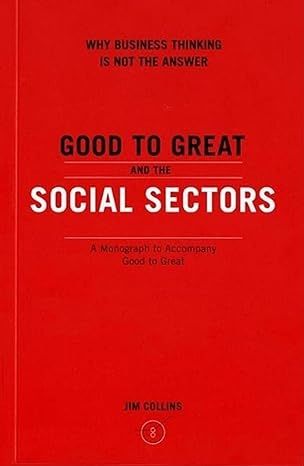
Good to Great and the Social Sectors: A Monograph to Accompany Good to Great (Good to Great, 3)
4.5
-
1,474
$6.00

Turning the Flywheel: A Monograph to Accompany Good to Great
4.6
-
1,230
$0.99
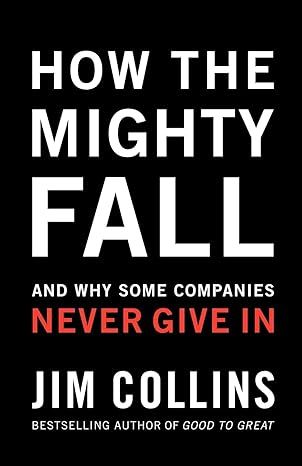
How The Mighty Fall
4.6
-
1,081
$0.99

BE 2.0 (Beyond Entrepreneurship 2.0): Turning Your Business into an Enduring Great Company
4.8
-
803
$0.99
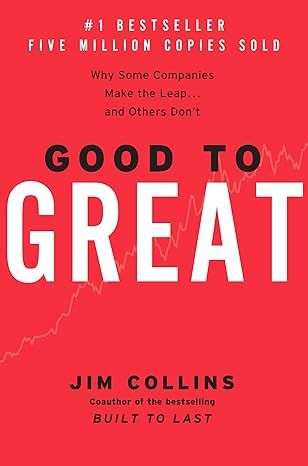
Good to Great: Why Some Companies Make the Leap...And Others Don't (Good to Great, 1)
4.5
-
9,099
$0.99
Best Sellers

The Tuscan Child
4.2
-
100,022
$8.39
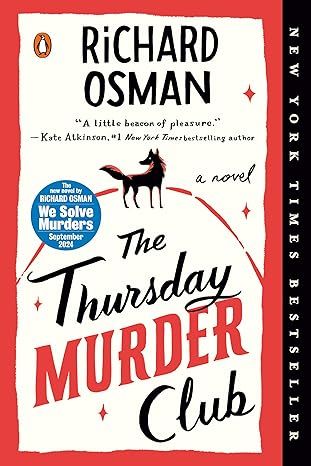
The Thursday Murder Club: A Novel (A Thursday Murder Club Mystery)
4.3
-
155,575
$6.33
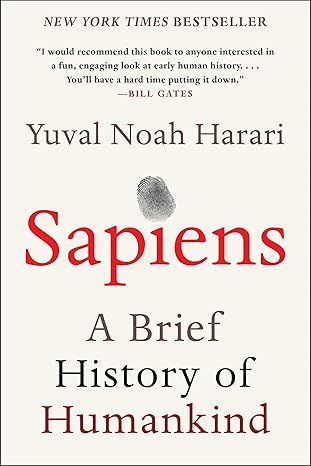
Sapiens: A Brief History of Humankind
4.6
-
140,302
$13.49

The Butterfly Garden (The Collector, 1)
4.3
-
88,556
$9.59

Things We Hide from the Light (Knockemout Series, 2)
4.4
-
94,890
$11.66

The Last Thing He Told Me: A Novel
4.3
-
154,085
$2.99

The Perfect Marriage: A Completely Gripping Psychological Suspense
4.3
-
143,196
$9.47
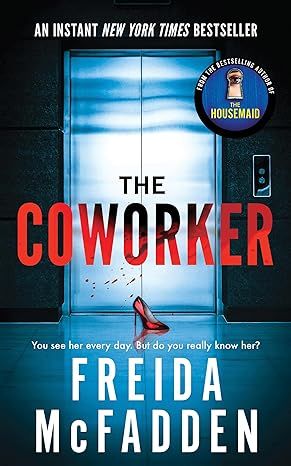
The Coworker
4.1
-
80,003
$13.48

First Lie Wins: A Novel (Random House Large Print)
4.3
-
54,062
$14.99

Mile High (Windy City Series Book 1)
4.4
-
59,745
$16.19

Layla
4.2
-
107,613
$8.99

The Locked Door
4.4
-
94,673
$8.53

